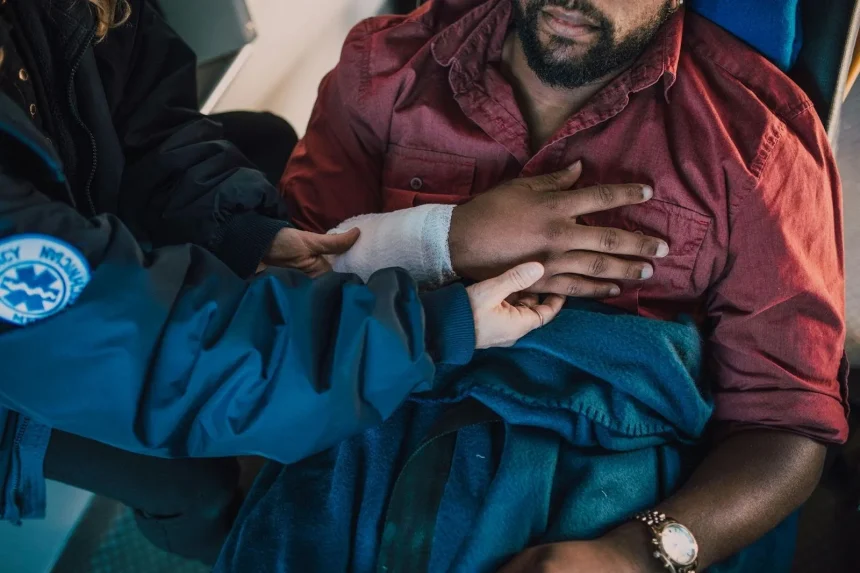Car accidents in Escondido, like anywhere else, can be disorienting and stressful, resulting in impromptu reactions that might not be the most beneficial in the long run. It is thus paramount to familiarize ourselves with the essential steps to take at the scene of a car accident, such as ensuring immediate safety, alerting the authorities, thoroughly documenting the scene, and seeking timely medical attention. As we further explore these steps, we will uncover their relevance and how they can directly impact your health, legal rights, and insurance claims.
Ensuring Immediate Safety
Upon the sudden jolt of a car accident, ensuring immediate safety is the paramount concern. Safety precautions in such scenarios include swiftly examining oneself and passengers for injuries, and if safe to do so, vacating the vehicle and moving to a secure location away from traffic.
Accident readiness is not typically at the forefront of most drivers’ minds, however, having a solid plan in place can drastically improve outcomes in such an unfortunate event. This involves carrying a safety kit in your vehicle that includes items like a first aid kit, flashlight, and warning triangles or flares to alert other drivers of the accident.
Moreover, do not underestimate the importance of mental readiness. Maintaining calm in the face of adversity enables one to make rational decisions under pressure. This includes remembering not to admit fault at the scene, as it may have legal implications down the line.
Alerting the Authorities
It is essential to promptly alert the authorities following a car accident. This involves making an emergency call, providing detailed information about the incident, and adhering to a certain etiquette when interacting with officers. These steps are not only legally required in many jurisdictions, but they also play a significant role in ensuring appropriate assistance and a correct accident record.
Making the Emergency Call
In the aftermath of a car accident, one of the most critical steps is making an emergency call to alert the authorities. The process may seem straightforward, but in high-stress situations, it’s crucial to follow the emergency protocol accurately to guarantee the correct type of assistance arrives promptly.
Start by dialing the emergency number, usually 911 in the United States. Try to remain calm, even though this may be difficult under the circumstances. The dispatcher on the line is trained to handle these situations and will guide you through the call details.
It is important to know your exact location or, if not, to provide as many details as possible about your surroundings to help the authorities locate you quickly. Communicate the severity of the situation, including the number of vehicles involved, if there are any injuries, and the conditions of the accident scene.
Reporting Detailed Information
After contacting emergency services, the next essential step is to provide detailed information to the authorities about the incident. Reporting an accident accurately and in detail can greatly impact the resolution of any potential disputes or legal issues that may arise later.
Start by giving a thorough account of how the accident happened, including the location, direction of travel, speed, weather conditions, and any other relevant circumstances. Be as precise as possible when describing the sequence of events leading up to the collision. This will be important in creating accurate accident diagrams, which are often used by law enforcement and insurance companies to understand the dynamics of the accident.
Next, gather witness statements. These can provide an impartial perspective on the accident and can be critical pieces of evidence. Identify any bystanders who may have seen what happened and ask them to share their observations. Encourage them to speak to the police when they arrive, as their statements can greatly influence the authorities’ understanding of the incident.
Officer Interaction Etiquette
Maneuvering the protocols of interacting with law enforcement at the scene of an accident can be challenging, particularly in the immediate aftermath of a collision. A respectful communication approach is essential in maintaining a calm atmosphere and ensuring that the officer’s demeanor remains professional and focused.
Understanding the officer’s role is key. They are there to secure the scene, assist the injured, and collect information for an official report. Cooperation with their directives is mandatory and vital for the smooth progression of procedures at the scene. Provide accurate, concise information about the incident without speculation or unnecessary details.
Respectful communication includes maintaining a neutral tone, avoiding argumentative language, and refraining from interrupting the officer while they are speaking or conducting their duties. Remember to address them as ‘Officer’ followed by their surname if it’s known, displaying courtesy and respect for their role.
The officer’s demeanor can often reflect the level of cooperation and respect they receive. A calm, respectful interaction can facilitate a more efficient and positive encounter. Remember, your behavior can influence their assessment of the accident scene and the subsequent report, which could impact insurance claims and legal proceedings.
Documenting the Accident Scene
A staggering number of accidents occur daily, making it essential to understand how to accurately document the scene. Proper documentation can serve as invaluable evidence in any ensuing legal or insurance processes.
Firstly, photographic evidence is vital. Use your smartphone to capture multiple angles of the accident scene, including close-ups of vehicle damages, skid marks, traffic signals, road conditions, and any other details that might be relevant. This visual information can provide an all-encompassing perspective of the incident to insurance adjusters and potentially law enforcement.
Simultaneously, it is equally important to collect witness statements. Independent third-party accounts can corroborate your version of the events. Note the names, contact information, and a brief summary of what each witness saw. Remember, these people are under no obligation to stay or share information, so approach them respectfully and thank them for their time.
Lastly, jot down your own recollection of the accident as soon as possible. Details can blur with time, and having a fresh, detailed account can be helpful. Confirm that your notes include the date, time, and weather conditions.
Exchanging Information With Involved Parties
After documenting the accident scene, the next critical step involves exchanging information with all parties involved in the incident. This process includes gathering necessary details such as names, contact information, and insurance data. In addition, it is essential to document any personal injuries immediately and report the incident to your insurance company in a timely manner.
Gathering Necessary Details
Steering through the aftermath of a car accident often requires a clear mind and a systematic approach. Gathering necessary details is a significant step that should not be overlooked. This primarily involves exchanging information with all parties involved, but it also extends to collecting evidence that accurately portrays the events leading up to, during, and after the accident.
It is essential to obtain witness statements. Witnesses can provide an unbiased account of the incident, which may be imperative if the case goes to court. Approach any bystanders who may have seen the accident, ask for their recollection of events, and request their contact information for potential follow-up.
Simultaneously, taking accident photos is equally important. Visual evidence can substantiate claims about the severity and cause of the accident. Use a smartphone or a digital camera to capture images of the vehicles involved, their positions, visible damages, and any contributing factors like poor road conditions or malfunctioning traffic signals.
Documenting Personal Injuries
Amid the chaos of a car accident, it is important to prioritize the documentation of personal injuries. This significant step can greatly impact the eventual outcome of any legal or insurance-related proceedings. Injury documentation starts at the scene; any visible injuries should be photographed as soon as safely possible. This includes minor bruises, cuts, or more severe injuries.
Additionally, it is important to maintain a record of any medical treatment received post-accident. Medical records serve as official, undeniable proof of the extent and nature of the injuries sustained. They can provide a detailed account of the injury, timeline of recovery, and the cost of treatment, all of which are invaluable in any legal or insurance claims.
Seeking immediate medical attention, even if injuries seem minor, is critical. Not only does this protect your health, but it also establishes a clear link between the accident and any injuries. Any delay in seeking treatment might be used against you to argue that the injuries were not a direct result of the accident.
Reporting to Insurance
Once the immediate medical concerns have been addressed, it is essential to report the accident to your insurance company and exchange necessary information with other involved parties. This step is critical to initiate your insurance claim and guarantee your policy coverage is activated.
Contact your insurance provider as soon as possible to report the accident. Give them a detailed account of the incident, including the time, location, and circumstances leading to it. Any photos or videos taken at the scene can provide valuable evidence supporting your claim.
In addition to contacting your insurance, it’s important to exchange information with the other parties involved. This information includes names, addresses, contact details, and insurance policy numbers. Confirm you also record the make, model, and registration number of the other vehicles involved.
If the police attended the scene, ask for a copy of their report. This documentation will be beneficial when processing your insurance claim.
Remember that honesty is paramount when reporting to your insurance. Any discrepancies or false information can lead to complications with your claim and could potentially affect your policy coverage. Taking these steps promptly and accurately will help streamline the claim process and expedite your road to recovery.
Reporting to the Insurance Company
Having navigated through the initial shock and confusion at the accident scene, your next crucial step is to report the incident to your insurance company. This should occur promptly after the accident, as delays can potentially jeopardize your insurance coverage.
When contacting your insurer, provide a detailed and accurate account of the accident, along with any related documentation like photos, witness contacts, and police reports. Your honesty and thoroughness at this stage are essential to the claims process.
The insurance company will assign a claims adjuster to investigate the case. Cooperate fully with this professional, providing any requested information in a timely manner. Failure to do so could result in delays or denials in your claim.
Seeking Medical Attention Post-Accident
While ensuring your claims process is underway is of utmost importance, your physical well-being should not be neglected in the aftermath of a car accident. Even if you feel fine, it’s essential to get a medical evaluation as soon as possible. Injuries may not be immediately apparent due to the adrenaline rush that often accompanies an accident.
A thorough medical evaluation will provide a detailed injury assessment that can highlight unseen or subtle injuries. This could include internal injuries, concussion, whiplash, or other soft tissue injuries. By promptly identifying these potential health problems, you can start treatment right away, which might prevent complications later on.
Bear in mind that some symptoms might not manifest until days or even weeks after the accident. Regular follow-ups with your doctor are therefore necessary to monitor your condition. These medical records will also play a significant role in your insurance claim, as they provide concrete proof of your injuries and the necessary treatment.
Seeking immediate medical attention post-accident is not just about your health. It’s also a key step in securing fair compensation for your injuries, making it an essential step to take at a car accident scene in Escondido.
Consulting With a Car Accident Lawyer
Maneuvering the complexities of the legal system can be an intimidating task, especially after the emotional upheaval of a car accident. Consulting with a well-experienced Escondido car accident attorney is an important course of action when involved in such incidents in Escondido.
There are numerous consultation benefits that arise from seeking legal advice from a trained professional. To begin with, an experienced lawyer can help you understand your rights and responsibilities following a car accident. They are well-versed in the intricacies of the law and can explain the best course of action for your specific situation.
Legal representation is also essential in ensuring the protection of your rights. A car accident lawyer can negotiate with insurance companies on your behalf, aiming for fair compensation for any damages and medical expenses incurred. If the case escalates to a lawsuit, your lawyer will be able to present your case effectively in court.
Lastly, a lawyer can provide emotional support during this stressful time by taking the burden of legal procedures off your shoulders. This allows you to focus on your recovery while your legal representative handles the complexities of the case. In conclusion, consulting with a car accident lawyer is an indispensable step following a car accident in Escondido.
Frequently Asked Questions
What if the Other Driver Refuses to Provide Their Information After the Accident?
If the other driver refuses an information exchange after an accident, document their refusal, collect any available evidence, and contact law enforcement. Subsequently, consult with a legal advisor to explore your legal options.
Do I Need to Contact My Insurance if Im Not at Fault for the Accident?
Yes, you should contact your insurance company even if you’re not at fault. This initiates the process of insurance claims, providing them details about the accident and establishing no liability on your part.
How Do I Deal With Aggressive Behavior at the Accident Scene?
Aggressive behavior at an accident scene can be addressed using de-escalation techniques. Maintaining calm, avoiding argumentative language, and seeking law enforcement help can effectively manage hostility, ensuring safety and smoother communication.
What Should I Do if I Suspect the Other Driver Is Under the Influence?
If you suspect the other driver is under the influence, observe signs of intoxication like slurred speech or impaired coordination. Document your observations and report them following proper protocols to the responding police officers.
Is There a Specific Timeframe to File a Lawsuit After a Car Accident?
In California, the legal deadline for filing claims after a car accident is typically two years from the date of the accident. However, it’s advisable to consult with a lawyer to understand any specific conditions.





